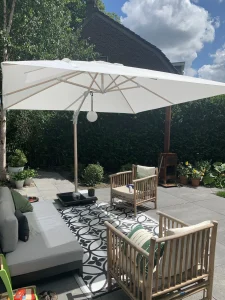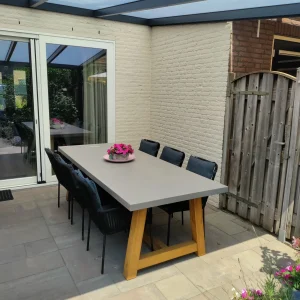De herfst is een bijzondere tijd van het jaar waarin de natuur zich voorbereidt op de winter. Terwijl de bladeren van kleur veranderen en de lucht frisser aanvoelt, is dit het perfecte moment voor tuiniers om hun tuinen voor te bereiden op de aankomende koudere maanden. Herfstonderhoud is essentieel om de gezondheid van je tuin te waarborgen en ervoor te zorgen dat deze in het volgende groeiseizoen weer tot leven komt. In deze blog delen we handige tuinklussen die je in de nazomer kunt aanpakken om je tuin in topvorm te houden.
Van het snoeien van bomen en struiken tot het planten van winterharde bloembollen, deze klusjes helpen niet alleen je tuin er verzorgd uit te laten zien, maar dragen ook bij aan de biodiversiteit en de algehele gezondheid van je groene ruimte. Door nu de juiste stappen te ondernemen, zorg je ervoor dat je tuin weer tot bloei komt in het voorjaar. Laten we samen ontdekken welke praktische tips en trucs je kunt toepassen om je tuin optimaal voor te bereiden op de winter!
Het Onderhouden van je Gazon
Het onderhouden van je gazon in de herfst is cruciaal voor de algehele gezondheid van je tuin en zorgt ervoor dat je gras sterk en groen blijft, zelfs in de koudere maanden. De nazomer en herfst zijn ideale momenten om je gazon een beetje extra zorg te geven, zodat het goed voorbereid de winter ingaat. Hier zijn enkele belangrijke stappen die je kunt volgen om je gazon in topvorm te houden.
- Maaien : Begin met het maaien van je gazon op de juiste hoogte. In de herfst is het aan te raden om je gras iets korter te maaien dan normaal, tot ongeveer 4 tot 5 centimeter. Dit helpt om schimmelgroei te verminderen en bevordert een gezonde luchtcirculatie. Zorg ervoor dat je maaimachine scherp is, zodat je een nette snede krijgt en de grasplanten niet worden beschadigd.
- Verticuteren : Verticuteren is een proces waarbij je de bovenste laag van de grasmat behandelt om vilt en mos te verwijderen. Dit is een belangrijke stap, omdat het de wortels van het gras meer ruimte geeft om te groeien en de opname van voedingsstoffen en water bevordert. Dit kan het beste worden gedaan in de herfst, wanneer het gras nog actief groeit, maar het risico op beschadiging door droogte kleiner is.
- Bemesten : Na het verticuteren is het een goed moment om je gazon te bemesten. Kies voor een meststof die speciaal is ontworpen voor de herfst. Deze bevat vaak een hogere verhouding aan kalium, wat helpt bij de winterhardheid van het gras. De meststof zorgt ervoor dat de wortels sterker worden en dat het gras goed voorbereid is op de winter.
- Water geven : Hoewel de herfst vaak meer neerslag met zich meebrengt, is het belangrijk om je gazon regelmatig water te geven, vooral tijdens droge periodes. Zorg ervoor dat je gazon een diepere, maar minder frequente bewatering krijgt, zodat de wortels dieper in de grond groeien. Dit helpt je gras om beter te overleven in de winter en zorgt voor een gezonde start in het voorjaar.
- Zaaien : Als je kale plekken in je gazon hebt, is de herfst een ideaal moment om graszaad te zaaien. Kies een graszaad dat geschikt is voor jouw klimaat en zorg ervoor dat je het zaad gelijkmatig over de kale plekken verspreidt. Dek het zaad lichtjes af met aarde en geef het goed water, zodat het kan ontkiemen.
- Bladeren verwijderen : Vergeet niet om gevallen bladeren regelmatig van je gazon te verwijderen. Een laag bladeren kan de grasmat verstikken en leiden tot schimmelvorming. Gebruik een bladhark of een bladblazer om de bladeren op te ruimen en houd je gazon gezond en ademend.
Door deze eenvoudige maar effectieve onderhoudstips toe te passen, geef je je gazon de beste kans om gezond en sterk de winter door te komen. Met een beetje zorg en aandacht in de herfst, kun je genieten van een weelderig groen gazon zodra het voorjaar aanbreekt. Maak van het onderhoud van je gazon een prioriteit en geniet van de voordelen die dit met zich meebrengt!
Snoeien en Vormgeven van Hagen
Snoeien en vormgeven van hagen is een belangrijke tuinklus in de herfst, vooral voor de onderhoud van een strakke en verzorgde uitstraling van je tuin. Hagen bieden niet alleen privacy, maar dienen ook als natuurlijke afscheidingen en bieden schuilplaatsen voor vogels en andere dieren. Een goede snoei helpt de hagen gezond te blijven en stimuleert een dichte groei. Hier zijn enkele richtlijnen om je hagen effectief te snoeien en te vormen in de herfst.
Timing is cruciaal : Het is het beste om hagen te snoeien aan het einde van de zomer of begin van de herfst, wanneer de groei van de meeste soorten is vertraagd. Dit voorkomt dat je nieuwe groei stimuleert die kan worden beschadigd door kou of vorst. Het snoeien in deze periode helpt ook om de hagen voor te bereiden op de winter, waardoor ze minder kwetsbaar zijn voor weersomstandigheden.
De juiste tools : Zorg ervoor dat je de juiste gereedschappen bij de hand hebt voordat je begint. Een scherpe snoeischaar of heggenschaar is essentieel voor een nette snede. Voor bredere hagen kun je een elektrische heggenschaar gebruiken om het proces te versnellen. Vergeet niet om je gereedschap goed schoon te maken en te ontvetten om de verspreiding van ziekten te voorkomen.
Snoeitechniek : Begin met het snoeien van de bovenkant van de haag en werk naar beneden. Dit zorgt ervoor dat je een gelijkmatige snede krijgt. Snoei altijd van boven naar beneden en probeer een taps toelopende vorm te creëren, waarbij de onderkant breder is dan de bovenkant. Dit helpt om de onderste takken voldoende zonlicht te geven, wat de groei bevordert. Vermijd het snoeien tot op de oude hout, omdat dit kan leiden tot een kale haag die niet goed terugkomt.
Verwijder dode of zieke takken : Tijdens het snoeien is het belangrijk om ook dode of zieke takken te verwijderen. Dit helpt niet alleen om de gezondheid van de haag te verbeteren, maar voorkomt ook dat ziekten zich verspreiden naar gezonde delen van de plant. Controleer zorgvuldig op schimmels of insecten en verwijder aangetaste takken.
Afwerking en opruimen : Na het snoeien is het belangrijk om de hagen een goede afwerking te geven. Dit kan inhouden dat je eventuele scherpe randen bijwerkt en ervoor zorgt dat de haag er netjes uitziet. Verzamel al het snoeiafval en verwijder het uit de tuin om plagen en ziekten te voorkomen.
Voeding : Overweeg om na het snoeien een organische meststof of speciale hegmest toe te voegen. Dit zal helpen om de planten te voeden en hen te voorzien van de nodige voedingsstoffen voor een sterke groei in het voorjaar.
Door regelmatig je hagen te snoeien en vorm te geven in de herfst, zorg je ervoor dat ze gezond en aantrekkelijk blijven. Een goed onderhouden haag kan jarenlang meegaan en een belangrijke rol spelen in het creëren van een mooie en functionele tuin. Neem de tijd om deze taak zorgvuldig uit te voeren en geniet van het resultaat!
Herfstmest voor je Planten
Herfstmest is een essentieel onderdeel van het onderhoud van je tuin in de nazomer en herfst. Het toedienen van meststoffen in deze periode helpt je planten zich voor te bereiden op de winter, zorgt voor een gezonde groei in het volgende groeiseizoen en stimuleert de algehele gezondheid van je tuin. In dit hoofdstuk bespreken we waarom herfstmest belangrijk is, welke soorten meststoffen je kunt gebruiken en hoe je deze het beste kunt toepassen.
Waarom herfstmest? : Tijdens de herfst beginnen planten zich voor te bereiden op de winter. Dit is het ideale moment om ze de voedingsstoffen te geven die ze nodig hebben om sterker en gezonder te worden. Herfstmest bevat meestal een hogere concentratie aan kalium, wat essentieel is voor de weerstand van planten tegen kou en vorst. Kalium helpt ook bij de ontwikkeling van sterke wortels, waardoor je planten beter bestand zijn tegen de winterse omstandigheden.
Soorten herfstmest : Er zijn verschillende soorten meststoffen die je kunt gebruiken in de herfst. Organische meststoffen, zoals compost en goed verteerde stalmest, zijn uitstekende keuzes. Ze verbeteren niet alleen de bodemstructuur, maar leveren ook langzaam werkende voedingsstoffen die de planten in de winter en het vroege voorjaar van dienst zijn. Kunstmest kan ook effectief zijn, vooral als het gaat om specifieke formuleringen die zijn ontworpen voor de herfst. Let op de verhouding van stikstof, fosfor en kalium (NPK) op de verpakking; een verhouding met meer kalium is ideaal voor de herfst.
Toepassing : Voordat je meststof aanbrengt, is het belangrijk om de bodem goed voor te bereiden. Begin met het verwijderen van onkruid en dode plantenresten uit je tuin. Dit zorgt ervoor dat de meststoffen beter in de grond kunnen doordringen en dat je planten optimaal profiteren van de voedingsstoffen. Verspreid de herfstmest gelijkmatig over de bodem rondom je planten. Zorg ervoor dat je de meststof niet te dicht bij de stam of basis van de planten aanbrengt, omdat dit schade kan veroorzaken. Gebruik een hark om de meststof lichtjes in de bodem te werken, wat helpt om de opname te bevorderen.
Timing : De beste tijd om herfstmest toe te passen is wanneer de temperaturen beginnen te dalen en de groei van je planten vertraagt. Dit is meestal in de late zomer tot het begin van de herfst, afhankelijk van jouw klimaat. Het is belangrijk om de meststof aan te brengen voordat de eerste vorst optreedt, zodat de planten voldoende tijd hebben om de voedingsstoffen op te nemen.
Paden en Terrassen Reinigen
Het reinigen van paden en terrassen in de herfst is een belangrijke klus die vaak over het hoofd wordt gezien, maar het kan een wereld van verschil maken voor de uitstraling en functionaliteit van je tuin. Gedurende de zomer kunnen paden en terrassen worden aangetast door een opbouw van vuil, bladeren, algen en mos. Dit kan niet alleen leiden tot een slordige uitstraling, maar ook gevaarlijke situaties creëren, zoals gladde oppervlakken. In dit hoofdstuk bespreken we effectieve manieren om je paden en terrassen grondig te reinigen en weer in topvorm te krijgen.
Voorbereiding : Voordat je begint met het reinigen, is het belangrijk om je materialen te verzamelen. Zorg ervoor dat je een bezem, een hogedrukreiniger, een schrobborstel en een emmer met water en een geschikt schoonmaakmiddel bij de hand hebt. Draag handschoenen en, indien nodig, een veiligheidsbril om jezelf te beschermen tegen eventuele spetters.
Bladeren en vuil verwijderen : Begin met het verwijderen van bladeren en ander organisch vuil van de paden en terrassen. Gebruik een bezem om het meeste vuil te verzamelen en gooi dit weg. Dit voorkomt dat er schimmel of ongedierte ontstaat onder de bladeren. Vergeet niet om ook hoeken en randen goed schoon te maken, waar zich vaak vuil ophoopt.
Schrobben van oppervlakken : Voor hardnekkige vlekken of aangekoekt vuil is het gebruik van een schrobborstel aan te raden. Meng een mild schoonmaakmiddel met water in een emmer en gebruik de schrobborstel om de oppervlakken grondig schoon te maken. Dit helpt om algen en mos te verwijderen, die niet alleen onesthetisch zijn, maar ook gladde plekken kunnen creëren.
Hogedrukreiniger gebruiken : Als je paden en terrassen een diepere reiniging nodig hebben, kan een hogedrukreiniger zeer effectief zijn. Dit apparaat verwijdert hardnekkig vuil, vet en algen met krachtige waterstralen. Zorg ervoor dat je de juiste drukinstelling gebruikt, afhankelijk van het materiaal van je terras of pad, om beschadiging te voorkomen. Houd de spuitmond op een afstand van ongeveer 30 centimeter van het oppervlak voor optimale resultaten.
Verzorgen van voegen en randen : Let ook op de voegen tussen de stenen of tegels. Deze kunnen vaak vuil en onkruid bevatten. Gebruik een onkruidbestrijdingsmiddel of een mengsel van azijn en water om het onkruid te bestrijden. Borstel de voegen daarna goed schoon en spoel ze af met water.
Afwerking : Zodra je paden en terrassen schoon zijn, overweeg dan om een beschermende coating of een anti-slipmiddel aan te brengen, vooral op gebieden die vaak nat zijn. Dit helpt om de levensduur van de oppervlakken te verlengen en maakt ze veiliger tijdens natte weersomstandigheden.











